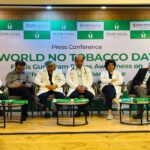- “They concurred that an integrated approach for awareness building and addressing availability, accessibility and affordability will play a critical role in making India nourished and healthy.
- The government was recommended to provide a food basket through PDS that now provides only one type of food which is reducing dietary diversification.
- India has 47 million children suffering from stunting, i.e., one-third of the global burden.
- Malnutrition may result in potential GDP losses of 2-3 per cent and may reduce the lifetime earnings for each malnourished individual by over 10 per cent.”
New Delhi, September 02, 2021:
Noting that the dietary imbalance is a major factor behind the rising number of non-communicable diseases in children and adults alike, experts at the second edition of mega Bharat Nutrition Week conclave, organised by the Integrated Health and Wellbeing (IHW) Council, a premier think tank promoting health for all, concurred that an integrated approach for awareness building and addressing availability, accessibility and affordability of food will play a critical role in making India nourished and healthy.
“There are three main aspects of the nutrition problem in India – malnutrition, hidden hunger, and diet-related non-communicable disease (NCD). India has 47 million children who suffer from stunting – this is one-third of the global burden. India is only second to China in diabetes, and if no preventive action is taken, we may soon beat China. Most of it can be managed through a healthy diet and physical activity. The government runs an NCD control programme in 100 districts across the country, but that needs to be extended throughout.
Also, Availability, accessibility, and affordability matters need to be addressed. The PDS helps people access food but it provides only one type of food which is reducing dietary diversification – our recommendation to the government is to provide a food basket through PDS,” says Dr A. Laxmaiah, Head, Public Health Nutrition, National Institute of Nutrition-ICMR.
“In the past year-and-a-half, we have focused on COVID and lost focus on nutrition. There is a multifactorial aetiology behind this nutrition problem. We need awareness about nutrition at multiple levels and need an intersectoral, inter-ministerial approach to reach the sustainable development goals 2 and 3,” says Dr Harshad Thakur, Director, National Institute of Health and Family Welfare (NIHFW).
Highlighting the importance of sound gut in absorbing nutrients, Ms. Ishi Khosla, Clinical Nutritionist, Centre For Dietary Counseling, says, “India produces sufficient food but not getting the benefit. Nutrition, as a science, is evolving and there is a need to understand inflammation better. Sound gut integrity is important as many problems happen due to poor gut health affecting absorption of nutrition. These are the areas we need to discuss and make people aware about.”
“Good nutrition begins in utero and gestational diabetes mellitus was among the first triggers when doctors turned to nutrition therapy for pregnant women – FIGO (The International Federation of Gynecology and Obstetrics) has a nutrition checklist that doctors follow. Our 1000 days journey through SHAPATH programme by IHW Council is based on this recent focus on nutrition.
It is important to keep on testing, tracking, and talking about nutritional deficiencies,” says Dr Hema Divakar, CEO and Chairman of Asian Research & Training Institute for Skill Transfer and Chair of Maternal and Child Health, IHW Council Advisory.
“Food is among the fundamental requirements for a healthy and productive life, and though we are in the 75th year of independence, not all Indians are able to eat as much as they should or need. According to the government’s own estimates, about 40 per cent children between 6 months and 5 years of age in 514 districts are affected by anaemia, a disease that can be prevented through the right amount of nutrition.
The prevalence of obesity among 5- to 19-year-old children, ranged between 3.6 and 11.7 per cent and is predicted to reach 17 million by 2025. The nutrition dichotomy in India is telling and the results can be very alarming. Some estimates show malnutrition may result in potential GDP losses of 2-3 per cent and can potentially reduce the lifetime earnings for each malnourished individual by over 10 per cent. This second edition of Bharat Nutrition Week will try to bridge the gaps so that we can tread on the path of Poshan-yukt Bharat,” says Mr. Kamal Narayan, CEO, Integrated Health and Wellbeing (IHW) Council.
The 2nd edition of Bharat Nutrition Week will continue to bring together experts, policy makers and government representatives, and entrepreneurs till 7th September to address the critical issues of bridging the nutrition gap caused by the pandemic, especially in the lower socio-economic groups, pregnant and lactating women, infants, and adolescents, as well as attempt to raise awareness and drive solutions pertaining to sustainable production, food fortification, and food safety and distribution. Recognising the need for a holistic discussion on its diverse aspects, IHW Council will bring together sessions that will meet diverse needs of Indians – while dedicated specialty nutrition sessions will focus on fighting diseases with food, Healthy Khayega India will bring together home chefs and Bharat Poshan Premier Quiz will bring teams from 6 schools from Delhi, Maharashtra, Karnataka, Uttar Pradesh, Rajasthan, Assam, and Bihar.
healthysoch







